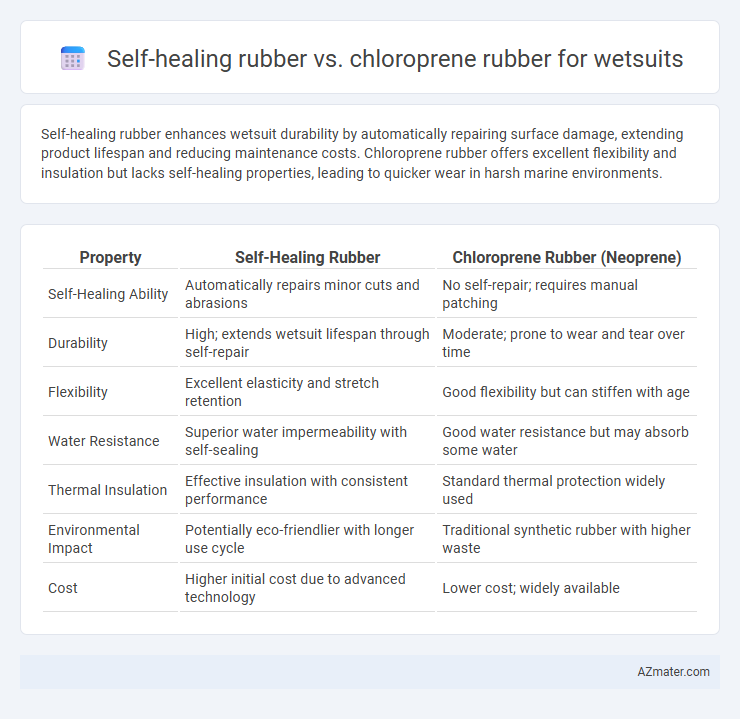Self-healing rubber enhances wetsuit durability by automatically repairing surface damage, extending product lifespan and reducing maintenance costs. Chloroprene rubber offers excellent flexibility and insulation but lacks self-healing properties, leading to quicker wear in harsh marine environments.
Table of Comparison
| Property | Self-Healing Rubber | Chloroprene Rubber (Neoprene) |
|---|---|---|
| Self-Healing Ability | Automatically repairs minor cuts and abrasions | No self-repair; requires manual patching |
| Durability | High; extends wetsuit lifespan through self-repair | Moderate; prone to wear and tear over time |
| Flexibility | Excellent elasticity and stretch retention | Good flexibility but can stiffen with age |
| Water Resistance | Superior water impermeability with self-sealing | Good water resistance but may absorb some water |
| Thermal Insulation | Effective insulation with consistent performance | Standard thermal protection widely used |
| Environmental Impact | Potentially eco-friendlier with longer use cycle | Traditional synthetic rubber with higher waste |
| Cost | Higher initial cost due to advanced technology | Lower cost; widely available |
Introduction to Rubber Materials in Wetsuits
Self-healing rubber in wetsuits offers enhanced durability by autonomously repairing minor cuts and abrasions, extending the lifespan of the gear. Chloroprene rubber, commonly known as neoprene, provides excellent insulation, flexibility, and water resistance, making it the traditional choice for wetsuit materials. Comparing these, self-healing rubber integrates advanced polymer chemistry for maintenance-free performance, while chloroprene balances comfort and protection with proven effectiveness in aquatic environments.
What is Self-Healing Rubber?
Self-healing rubber is a type of elastomer engineered to repair tears and punctures autonomously through reversible chemical bonds or embedded microcapsules that release healing agents upon damage. In wetsuit applications, self-healing rubber enhances durability and extends the lifespan by preventing water ingress and maintaining insulation despite minor cuts or abrasions. Compared to traditional chloroprene rubber, which offers good flexibility and weather resistance but lacks self-repair capabilities, self-healing rubber represents an advanced material innovation aimed at improving wetsuit performance and reducing maintenance.
Overview of Chloroprene Rubber (Neoprene)
Chloroprene rubber, commonly known as Neoprene, is a synthetic elastomer extensively used in wetsuit manufacturing due to its excellent flexibility, water resistance, and thermal insulation properties. Its molecular structure provides superior chemical stability and resistance to degradation from UV rays, ozone, and weathering, making it ideal for prolonged aquatic exposure. Compared to self-healing rubber, Chloroprene rubber offers proven durability and consistent performance in maintaining warmth and flexibility under varying water temperatures.
Durability: Self-Healing vs. Chloroprene Rubber
Self-healing rubber wetsuits offer enhanced durability by automatically repairing minor cuts and abrasions, extending the lifespan of the material in harsh marine environments. Chloroprene rubber, commonly used in wetsuits, provides excellent resistance to wear and flexibility but lacks the ability to self-repair, making it more susceptible to permanent damage over time. The self-healing properties significantly reduce maintenance needs and improve overall performance longevity compared to standard chloroprene rubber.
Flexibility and Comfort Comparison
Self-healing rubber exhibits superior flexibility compared to chloroprene rubber, allowing wetsuits to conform more naturally to the body's movements and enhance overall comfort during prolonged use. The advanced polymer matrix in self-healing rubber reduces stiffness while maintaining durability, resulting in a wetsuit that feels lighter and less restrictive. Chloroprene rubber, although widely used for its thermal insulation, tends to be less flexible and can cause increased fatigue due to its heavier, stiffer material properties.
Thermal Insulation Performance
Self-healing rubber exhibits advanced molecular structures that enhance thermal insulation by reducing micro-cracks, maintaining wetsuit integrity under prolonged exposure to cold water. Chloroprene rubber, commonly used in standard wetsuits, provides effective thermal insulation due to its closed-cell foam structure but may deteriorate over time, compromising heat retention. Wetsuits made with self-healing rubber offer superior thermal performance and durability, ensuring consistent thermal protection for extended aquatic activities.
Environmental Impact and Sustainability
Self-healing rubber in wetsuit manufacturing offers significant environmental advantages over chloroprene rubber by extending product lifespan and reducing waste through its ability to repair minor damages autonomously. Chloroprene rubber, commonly used in wetsuits, poses sustainability challenges due to its petrochemical origin and the emission of hazardous substances during production and degradation. The adoption of self-healing rubber contributes to sustainability by lowering resource consumption and minimizing ecological footprint, aligning with growing demand for eco-friendly wetsuit materials in outdoor and marine activities.
Repair and Maintenance: Which One Wins?
Self-healing rubber wetsuits offer a significant advantage in repair and maintenance by automatically sealing minor cuts and abrasions, reducing downtime and the need for professional repairs. Chloroprene rubber, while durable and widely used, requires manual patching and adhesive application for damage, making maintenance more labor-intensive and less efficient. The self-healing capability in specialized rubber formulations ultimately delivers superior convenience and longevity for wetsuit users focused on quick, hassle-free repairs.
Cost Considerations for Divers and Surfers
Self-healing rubber wetsuits generally cost more upfront compared to chloroprene rubber due to advanced materials and technology that extend the product's lifespan and reduce repair expenses for divers and surfers. Chloroprene rubber wetsuits offer a more budget-friendly option with widespread availability and reliable insulation, but may incur higher long-term costs due to frequent wear and tear repairs. Investing in self-healing rubber can be economically advantageous for frequent water sports enthusiasts seeking durability and reduced maintenance over time.
Future Trends in Wetsuit Material Innovation
Self-healing rubber in wetsuits offers advanced durability and extended lifespan by autonomously repairing minor damages, outperforming traditional chloroprene rubber in resilience and sustainability. Emerging material innovations prioritize eco-friendly, self-healing polymers embedded with microcapsules or reversible bonds to enhance performance under extreme conditions while reducing environmental impact. Future wetsuit developments will likely integrate smart, adaptive materials combining self-healing capabilities with thermal insulation to optimize wearer comfort and gear longevity.

Infographic: Self-healing rubber vs Chloroprene rubber for Wetsuit
 azmater.com
azmater.com